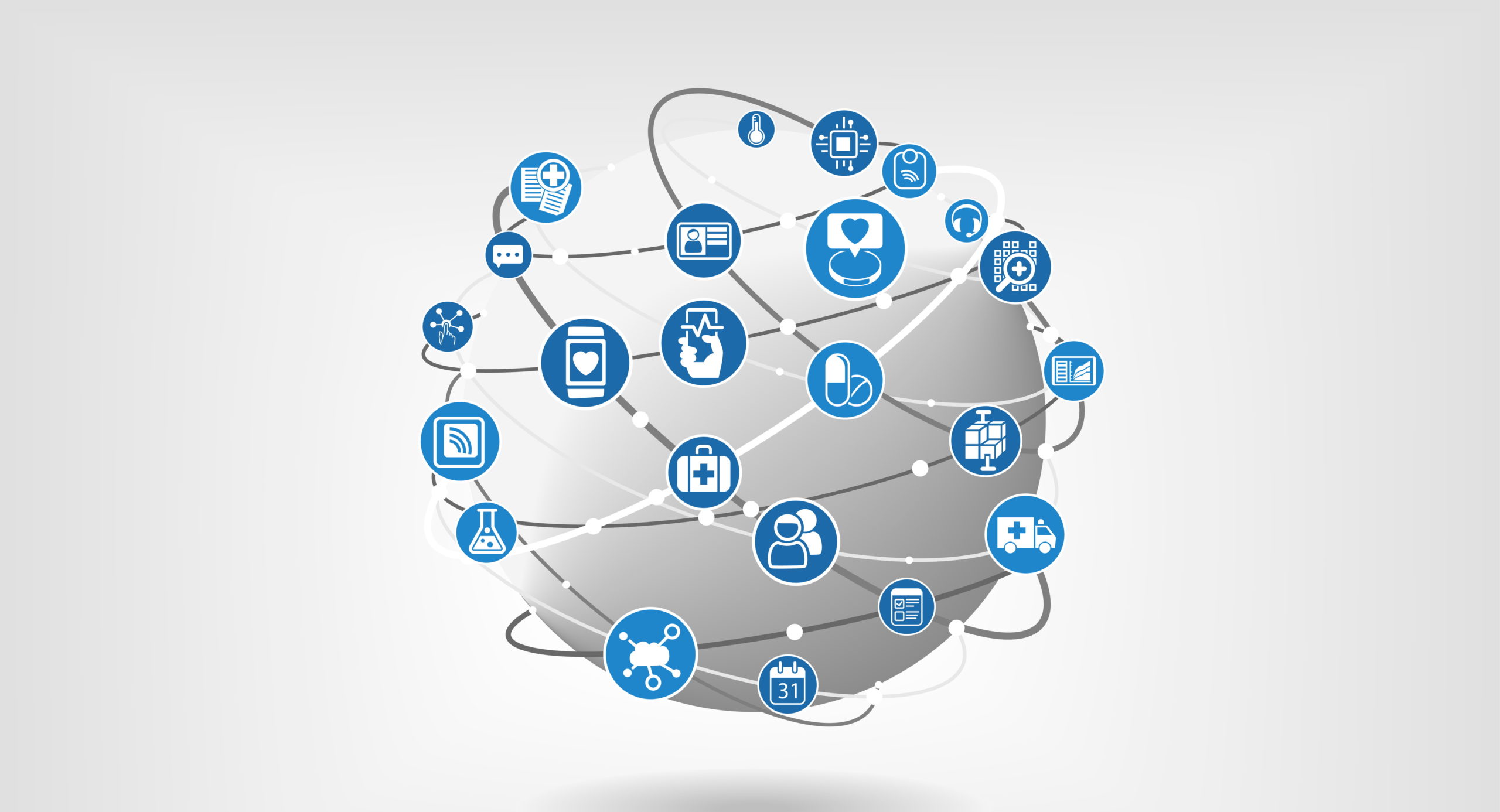The healthcare industry has been undergoing a digital transformation for quite some time, accelerated aggressively by the COVID-19 pandemic. The two main groups of people in this global arena are the healthcare consumers (patients) and healthcare providers. The win-win will occur as each group gains greater accessibility to the other. Digital transformation carries hope to populations in underdeveloped countries previously unable to be diagnosed, let alone treated. Additionally, digital healthcare facilitates the transport of health solutions to the patient rather than the other way around. COVID-19 vaccinations are a recent example.
Those in the medical field are nervous as they watch digital transformation flipping the traditional healthcare delivery model on its head. Will Artificial Intelligence (AI) and Machine Learning (ML) replace trained technicians? Will doctors need to go to medical school in the future? And there is even a bigger question: Will digital transformations result in better healthcare outcomes, or worse? Who (or what) is going to make the “tough calls”?
Almost every industry is exploring the potential and the opportunities presented by digital transformation in the current environment, and healthcare is no different. According to Grandview Research, the size of the global digital health market was valued at $96.5 billion in 2020 and is expected to increase at an annual compounded growth rate of more than 15% by 20281.Today, people can talk to their doctors over mobile phones, get tests read by machines, and wear devices that send health information through the cloud. But is the data secure? What is at stake if we embrace digital transformation in healthcare? What is at stake if we don’t? Or if we don’t do it correctly?
Digital healthcare past, present, and future
According to Statistia.com2, the United States’ digital health market was $25.3 billion a scant five years ago in 2016. It was composed of mHealth (mobile health), Healthcare Analytics, and Digital Healthcare Systems, with the latter representing the most significant portion, and Telehealthcare was not in the picture yet. The Statista.com estimate for the total 2021 U.S. digital health market is $70.2 billion, more than double. The greatest growth area comes from the mHealth sector, growing from $7.2 billion to $32.8 billion over the same period.
Several factors contribute to the high growth rate of all segments: 1) uniformity and access, 2) the need in the market (COVID is only one example but a major game-changer), 3) the advent of technology, and 4) the internet access being faster than ten years ago in many parts of the world, which enables the timely transfer of information. 5) The relaxed regulations for healthcare providers to be reimbursed for telehealth3.
The aging population has learned to be more tech-savvy after COVID, and as a result, can be managed more easily with digital health for treatments of chronic conditions (diabetes, heart disease, etc.) According to a McKinsey report, providers are seeing 50 to 175 times the number of patients through telehealth channels than pre-COVID4. Transfer and reading of radiology reports from across the globe can be accomplished efficiently and the time reduced by using mobile X-ray and ECG (electrocardiogram) machines. A diagnosis can be made, and the treatment plan passed quickly through the internet, often saving lives. Robotics5 is being used for testing, analysis, diagnostics, and treatment for nearby patients to reduce travel and prevent the spread of disease. Many chronic conditions like cardiovascular disease and diabetes can be managed with applications that monitor patients’ vital information and alert the patient when action is required. Wearable technology handles health data collection (i.e., heart rate, oxygen levels, blood sugar) for high-risk patients, making physician (and ER trips) less necessary through remote patient monitoring devices such as pulse-oximeters and heart monitors.
Telehealth, mHealth, and the devices and apps that support them offer worldwide uniformity, equality, and accessibility in the level of services provided. Technology facilitates the transfer of information so that trained medical providers can deliver their knowledge to more people than ever before. Healthcare digital transformation will not happen automatically, nor is it without pitfalls. And, it won’t work at all without simultaneous work in five critical areas.
Five areas that need special attention
As the reliance on technology in medicine and healthcare increases, the industry overseers will have to address these five areas for us to be able to call it a success and sleep at night.
- Predictive modeling, AI, and ML will take on greater importance: 84% of leaders in the industry believe that artificial intelligence will transform healthcare soon6. No one can be satisfied with the current state-of-the-art and must keep pressing forward.
- Healthcare wearables and compliance. Exercise trackers, heart rate sensors, oximeters to monitor oxygen levels in the blood, and sweat meters to monitor blood sugar levels in diabetic patients enable remote monitoring of patients6. Patients’ compliance, and continued improvements in these tools will enhance data-capturing in the digital space.
- Better communications delivery systems can be achieved through mobile devices, blockchain, Big Data, etc. but the existing global, socioeconomic, and generational Digital Divide could slow progress in this area7.
- Privacy and security must be in enforced globally to prevent hacking—something comparable to the U.S. Health Insurance Portability and Accountability Act (HIPAA), but respecting local requirements, which may be exceed US HIPAA regulations, or be unclear8.
- Accessibility: Quality, state-of-the-art healthcare is made available globally and locally to at-risk groups, e.g., aged, low-income, geographical, long-term disease, etc. Unfortunately, emerging markets do not have equal access to smartphones, nor to stable, reliable internet services.
Common mistakes in transitioning to digital applications in healthcare
Some enterprises try to tiptoe to the edge of incorporating digital applications without addressing the transformation head-on. Leaders worry about their own job security and their employees’ as well. Will a robot replace them? Will patient health data be analyzed more quickly and more thoroughly by AI using Big Data and cloud-based ML system than by humans?
On the other hand, companies and health care providers that move too slowly in adopting new techniques can find themselves at a competitive disadvantage and lose market share. A careful approach—while appearing safe in the near term—could prove to be short-sighted.
Two sides of the coin
There are disadvantages and advantages of healthcare digitalization. Companies need to consider both and then take the appropriate action steps. The disadvantages are:
- Initial investment required to bring software and hardware to current and future levels is hefty.
- Increased risks with global privacy undermined by acts such as ransomware against ever higher-profile targets. At the same time, global adaptation to electronic healthcare information is not occurring at the same pace, including protection against data breaches.
- Loss of control. The companies could rely too much on technology, which can be misused if it is “over-trusted,” or used in place of individual reasoning, training (education), and in-the-trenches experience.
Alternately, the advantages of healthcare digitalization can outweigh the disadvantages. They include:
- Reduced costs in the long run and better safety through investments in software and hardware.
- Increased socialization and accessibility produce more widespread availability of quality medical care resulting in a global win-win.
- Improved quality of services by reducing the number of medical errors, developing predictive medicine, and increasing the efficiency of clinical trials6.
Digital transformation in healthcare or anywhere else is not seeking a way to eliminate people’s jobs. The more positive aspect is that improved technology enhances work/life balance and achieves a better matchup of medically-related personnel (in this industry) to their specialties across the board, from technicians to researchers to clinicians. AI will not replace human decision-making but rather augment the available information from which individuals can make superior assessments and life-saving treatment plans. Changing technologies makes everyone anxious, as they always have. But new digital technology will serve the medical community in the same way automation made farming easier, more efficient, and more productive.
Overcoming obstacles to successful healthcare digital transformations
Resistance to change and fear of losing jobs could keep digital healthcare transformation from being effective on the providers’ side of the ledger. Traditions and fear of interacting with technology may thwart transformation attempts on the patient side.
On the provider side: Providers may be unwilling to share information for competitive reasons. Newer players are afraid of failing. Yet, the first few tries won’t necessarily work. Keeping pace requires investing in hardware and software, hiring when necessary, and training where gaps exist.
On the patient side: People in remote areas of the world may not trust the providers at first. As a silver lining, COVID may have helped in this regard as it became clear that many people previously without an entrée to modern healthcare were given access to it.
Successful digital transitions in healthcare
Many companies have seen the opportunity to make a difference in the wide-open digital healthcare industry. Here are a few examples: Peninsula Regional Medical Center, Newcastle Hospital, and Halifax Health9.
- Peninsula Regional Medical Center: The Director of Pharmacy at this Salisbury, Maryland medical facility initiated an AI-based tool to help their healthcare specialists prescribe the right medications using natural language and reducing the learning curve to access life-saving pharmacological data.
- Newcastle Hospital: Their Simulation Center in the UK Training Center uses a variety of Virtual Reality (VR) courses to improve surgeons’ skills. Augmented Reality (AR) and Extended Reality (XR) courses are becoming part of hospital transformations worldwide.
- Halifax Health: Halifax Health is a leading healthcare provider in Florida whose growth was restricted by its outdated IT infrastructure. As of 2017, they were operating over 700 virtual servers, which boosted the business tremendously. The company has also invested in technology to improve communication between the provider and patient, which helped improve their efficiency significantly.
Long-term impact
The growth of the internet in all sectors of the globe has provided a powerful platform for delivering technological advances to all industries, including healthcare and medicine. Digital transformation can have a significant impact on the well-being of patient consumers and medical professionals alike. Geography is no longer a barrier. If tests can be performed locally, the analysis and diagnostics can be executed anywhere and in real-time.
Cures, treatments, and wellness can spread like a virus as delivery systems become smoother and more trustworthy. Patients everywhere will have better attitudes as they see results and then work toward compliance (more difficult in some environments) as their health improves. With this change, the health spiral spins upward instead of downward.
Companies that are successful in delivering digital transformation initiatives in the medical/healthcare area will be 1) continually improving their systems, 2) resolutely investing in privacy and security, and 3) constantly increasing accessibility. The transformation will not always be perfect. But providers and recipients must have faith that while technology makes us better, it does not replace us.
We’ve found that people on this innovation highway care deeply. And while there may be temporary bumps on the road, we can gain by leveraging the fruits of technology. From Big Data to tiny monitoring devices, the benefits to clinicians and technicians in making informed decisions around the world should outweigh the risks—if properly executed and managed—to produce a global win-win. Electricity was new at one time, yet people learned to cope with its dangers and reaped the benefits. Each new technology builds on those before it. Humanity will manage its mistakes, adapt and learn as we go. While healthcare innovation is scary because people’s lives are at stake, we think that doing something a little risky is better than doing nothing.
References
1 Digital Health Market Size, Share & Trends Analysis Report By Technology
2 Digital health market size in the United States from 2014 to 2024, by technology
3 Telehealth: Delivering Care Safely During COVID-19
4 Telehealth: A quarter-trillion-dollar post-COVID-19 reality?
5 Coronavirus outbreak: doctors use robot to treat first known US patient
6 Digital Transformation in Healthcare Industry » 9 Aspects
7 How Technology Is Isolating Our Elderly and How to Fix It
8 How We Use HIPAA Standards Internationally While Respecting Local Communities
9 Digital Transformation Stories: How Pfizer and Halifax Health Foster Innovations in Healthcare
About the Author
 Sheetal Nariani has over 13 years of experience in the global healthcare industry and has successfully led multiple functions, including financial management, mergers and acquisitions, business operations, and corporate strategy. She specializes in managing integration and change management across diverse teams and cultures with a passion for travel. She is an alumna of Stanford University with dual degrees in Business Management and Public Policy and can be reached at sheetalnariani@alumni.gsb.stanford.edu
Sheetal Nariani has over 13 years of experience in the global healthcare industry and has successfully led multiple functions, including financial management, mergers and acquisitions, business operations, and corporate strategy. She specializes in managing integration and change management across diverse teams and cultures with a passion for travel. She is an alumna of Stanford University with dual degrees in Business Management and Public Policy and can be reached at sheetalnariani@alumni.gsb.stanford.edu
Tag/s:Business TransformationCOVID-19Digital DisruptionHealthcare







